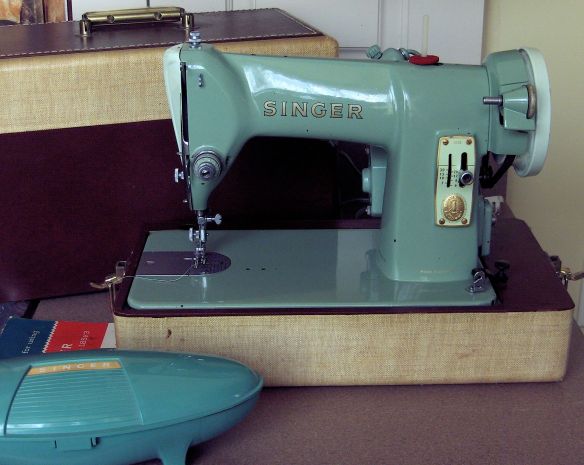I realized that I’ve never posted here about The Herd, which is my collection of vintage sewing machines. Now’s the time to start! I’ve been pulling them out of the closet this year to give each one a run, so why not post about the machines, too?
The first one to break out of storage was my Singer 185. It’s a 3/4 size machine in a lovely vintage green.
The Singer 185 is a straight stitch machine and a real workhorse. As you can see, I found it along with the Singer buttonhole attachment in what my husband calls the spaceship box. (You can also find it in a plain cardboard box, the way my mom’s was.) This buttonholer makes the most awesome keyhole buttonholes. You attach it like a huge foot to the machine, and choose the size of the buttonhole from cams included with the attachment. (If you ever see one and don’t have one already, grab it!)
My 185 is in the Singer canvas covered box, part of which is the base of the machine. There’s also a version with a light green plastic carrying case, which also provides a base. I’ve seen these for sale but think they’re a bit flimsy and I don’t love the green. You might also find this machine set into a table. It was also made in taupe and brown. According to the Singer UK website, the green 185 was available only in the US and Canada. The machine was manufactured from 1958 to 1963. The story is that you can tell from the machine number where it was made: the 185K was made in Kilbowie Scotland; the 185J was made in St-Jean-sur-Richelieu, Quebec, Canada; the 185 (without a letter) was made in the US. There’s evidently a bit of mixy-mixy with this that might be an English Canada thing – mine is badged as a 185K, which means it was made in Scotland, but it’s green, which is a North American product. It has North American wiring and the badge on the motor says Made in Canada, so I suspect the machine was made in the UK and wired in Quebec. Maybe it was imported and the wiring was changed once it arrived. (?) Maybe that’s why it has the canvas-covered box instead of the green plastic one. I’ve seen others that say “Made in Canada” on the machine itself, but mine doesn’t have that.
You’ll find the serial number of the machine on the bottom on the underside of the front. (You have to take the machine out of the case to see it.) Mine is EN771159. The ISMACS website maintains a list of Singer serial numbers and their manufacture dates: this machine was in the batch of 50,000 99’s and 185’s made in August 1958.
The beauty of a straight stitch machine is that there’s not much to go wrong. Mine doesn’t have a manual anymore, but it was in good working order. Even the tension was fine. Mine came without extra feet or attachments, but all the regular Singer feet work on it and even my cheap eBay walking foot is fine. The lever to the right of the stitch length selector has a screw on it so you can set its position – you push it up to backtack, then it’s easy to return to your set stitch length. There’s a blog post here on the Mermaid’s Den site about servicing a Singer 185 if yours needs more TLC than mine did. (The link there to the manual on the Singer site is a dead link, just FYI.)
I used this machine to piece both of my test quilts, and to quilt the first one. I also pieced the Mermaid Quilt with it. I like it a lot. It’s a little more clattery than my other machines but it works just fine. The feed dogs don’t drop but I quilted easily with it using the walking foot. I discovered that it tends to stop with the needle up, so when I took a pause in quilting, I had to remember to put the needle down before anything moved. That’s really not a bit deal. The electrical is still fine on it, but I unplug it when it’s not in use, just in case. I think I paid about $75 for it at an antique market, which included the buttonholer.
Next time we visit the Herd, we’ll talk about my vintage Elna collection. 🙂

